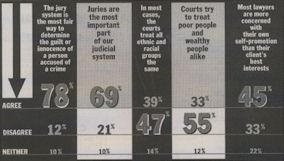 of 1,000 adults
which was conducted last August. of 1,000 adults
which was conducted last August.Among the other findings:
 78 percent believe the jury system is the fairest
way to determine guilt or innocence and 69 percent think juries are the most important
part of the American justice system. 78 percent believe the jury system is the fairest
way to determine guilt or innocence and 69 percent think juries are the most important
part of the American justice system.
 Only 14 percent could identify William H.
Rehnquist as the chief justice of the United States, and only one-quarter of those
surveyed could identify even one of the three branches of government. Only 14 percent could identify William H.
Rehnquist as the chief justice of the United States, and only one-quarter of those
surveyed could identify even one of the three branches of government.
 Just over half think convicted criminals are not
punished severely enough, and 68 percent think too many are set free on technicalities. Just over half think convicted criminals are not
punished severely enough, and 68 percent think too many are set free on technicalities.
Despite the survey's key finding that eight out of 10 adults believe the American
justice system is the best in the world, ABA President Philip S. Anderson said he was
troubled that 47 percent of those questioned feel that courts do not treat all racial and
ethnic groups the same.
 "This is
a very serious problem and it is one that we cannot afford to ignore," Anderson said.
He noted that only 16 percent of white lawyers said they had witnessed racial bias in the
justice system in the last three years, while 67 percent of black lawyers said they had. "This is
a very serious problem and it is one that we cannot afford to ignore," Anderson said.
He noted that only 16 percent of white lawyers said they had witnessed racial bias in the
justice system in the last three years, while 67 percent of black lawyers said they had.
"This raises the obvious question that if people believe the justice system is
tainted with bias, how long can they expect the courts to remedy bias elsewhere in our
system? . . . We are concerned that the current perception of bias will eventually erode
confidence in our system of justice."
Respondents were asked the same questions about confidence that were posed in a 1978
survey, and found significant increases in the public's confidence in key components of
the justice system.
The levels of confidence in all kinds of courts - the U.S. Supreme Court, other federal
courts, and state and local courts - have increased, although in some cases the level of
confidence remains low. Half of those polled said they were "extremely or very
confident" in the U.S. Supreme Court, compared with 36 percent in 1978. Thirty-four
percent showed strong support in other federal courts and 28 percent expressed strong
confidence in state courts.
In contrast, only 18 percent ex-pressed strong confidence in the U.S. Congress, and 14
percent expressed strong confidence in lawyers.
Pollsters also questioned people about their confidence in other professions. The news
media is at the bottom of the heap, with only 8 percent expressing strong confidence in
news organizations. Confidence in doctors, organized religion and public schools declined
in the past 20 years.
When it comes to information about the law itself, those questioned demonstrated large
gaps in their knowledge. More than one-third (37 percent) believe incorrectly that a
criminal defendant has to prove his or her innocence. At the same time, 99 percent know
that "anyone accused of a crime has the right to be represented in court by a
lawyer."
A surprising 96 percent know that a criminal defendant who is found not guilty still
can be sued in civil court. The survey speculated that such a high degree of knowledge
about a "relatively obscure concept" can most likely be attributed to publicity
about the O.J. Simpson murder trial and subsequent wrongful death civil case.
Although the questions were different, a "legal literacy" survey conducted by
the State Bar of California in 1991 also found a general dearth of legal knowledge in the
state. However, while the ABA survey found that 63 percent of respondents believe a
defendant must prove his or her innocence, the California poll found that 48 percent of
those questioned held the same incorrect belief.
Because nearly two-thirds of those questioned said they want to know more about the
courts, Anderson used the poll results to call on the Supreme Court to open its chambers
to cameras.
"One television camera in the Supreme Court will educate more people more
effectively in one morning than the traditional methods can reach in one year," he
said.
The survey was conducted by M/A/R/C Research, an independent research firm in Chicago,
and has a margin of sampling error of plus or minus three percentage points. |

